As for Jonathan Jones, I hope I shall not be considered too critical a critic – a critic’s critic, even – if I say that this method of deciding what he likes or dislikes is far too cumbersome for the everyday needs of an art critic, especially one as prolific as this critic, and that he does, of course, something far simpler the moment he gets out of the hushed confines of the gallery: he tosses a coin.
The result in the case of Edvard Munch, whose work is currently to be seen at the British Museum, was very good for Munch, but a disaster for art criticism. Having droned on about the artist’s life, a sure sign in any such piece of a lack of anything better to say, telling us how tragic it was, how he was an itinerant bohemian, how he never recovered from various bereavements and addictions, Jones attempts to conclude his critique with a flourish, an uplifting paragraph of rhetorical magnificence. He is, naturally, trying to sound profound about the one work by Munch that everyone has seen and which no one finds profound any more, if they ever did, ‘The Scream’:
It is a work of art that abolishes the distance between us. Even as he portrays despair and loneliness and death, Munch does so in a way that celebrates our ability to communicate with each other. He leaves you harrowed yet inspired. This is an exhibition that shows why we need art. How else can we hear each other scream?
I scream, you scream, we all scream. For ice cream.
It was at this point that I did just that – I screamed. Thankfully, no one heard me, least of all Jonathan Jones. Because I hate to alarm the neighbours, I screamed silently. It’s just as well JoJo will never learn about my inward screaming as you know what he’d say: “Aha, you see, that’s my whole point. That’s why we need art. How else can we hear each other scream?”
At the risk of exaggeration, this final sentence in his article on Munch is the worst JoJo has ever come up with, which is why I dearly wish it had been tails, not heads, and that he’d written one of his stinging diatribes against the Norwegian artist, rather than leaving that job to me, but also because the world would never have been exposed to such an appalling sentence. Too late. The world must try to cope.
It is so bad, that sentence, because it is so far from an accurate definition of why we need art, and so random an answer to that obvious riddle, that it makes one wonder if we actually do need it. Fortunately, I was able to catch the Bonnard exhibition at Tate Modern a few days before I attended the Munch and, therefore, I knew that art could do other, better things, and that even if I could easily have done without Bonnard, it was quite nice to have spent some time in his company. Bonnard the artist that is. I was utterly indifferent to Bonnard the man. I entirely ignored some black and white footage they had of him. As a man he might have been insufferably egotistical – let’s face it, the odds are he was, being an artist – and quite possibly gloomy, but the paintings don’t convey that idea. Bonnard the artist is the ultimate sunny optimist, though without being facile or sentimental.
So much for Bonnard. You could not imagine a style more antipathetic to the introspective musings of the Norwegian, or further removed from the angst that was promised (and delivered, along with a dollop of love) by the British Museum. The problem with all this symbolist brooding and Nordic noir is that it thinks it’s being profound. And yet, Skrik (as the artist called it, once he’d pared the image down, a word closer to the English ‘shriek’) is only as profound as you make it. On a certain level, it’s a crude piece that verges on caricature and could easily be dismissed as, well, facile or sentimental.
‘But how can you say that?’ I hear you cry. ‘How can you possibly say ‘The Scream’ is not profound?’ I shall go one further, and I am not alone in stating this, no one actually sees the thing any longer. People compare it to Mona Lisa for this one reason – unless I’m mistaken and they see both pictures as searching portraits of the human condition – that it has become over-familiar to the point where we can no longer see it. Or, as Siri Hustvedt put in the New York Times (they don’t mince their words, those New York Times critics):
As with the ‘Mona Lisa,’ whatever it may have meant to those who first saw it, the canvas has been buried under layer upon layer of cultural excrement.
In other words, she thinks of it as covered in shit. Compare what might happen, eventually, to a statue in a pigeon-filled square, were there no guardians around to cleanse our doors of perception: the proud features of whatever general or mercenary was represented would one day be obliterated, and the plinth would appear to be occupied by a grey, featureless stalagmite of… culture.
I suppose we critics are among the dirtiest pigeons in this analogy. Even as we add to the quantity of grey stuff, we participate in the general blindness to what lies underneath.
This phenomenon – which, being more decorous than Ms Hustvedt, I shall euphemistically refer to as ‘the guano syndrome’ – was perfectly illustrated even as I approached the version of The Screech in this exhibition. I had to pause, not in resistance to the irresistible pull of the picture, but because a young man in red was standing athwart the print, with his back to it, taking a selfie. Blithely unaware of the museum’s health warnings about angst, he was smiling with unconstrained delight while the screaming face on the bridge, like the Mona Lisa on such occasions, failed miserably to photobomb him. The young man then sent this shot of himself beaming around the world on some social media platform or other, and I mean beaming, since his expression could not have been in more stark contrast to the angst-ridden screamer. ‘Ah,’ I mused, sagely, ‘that’s why we need technology. How else could we see each other beam?’
What unites me, in my indifference to the picture, and the blithe young man in his incongruous joy, and anyone else on whom the picture no longer casts the appropriate spell, is the sheer quantity of culture covering it. A similar difficulty afflicts Scandinavians, but for them its far worse. In fact, I have a hunch the young man was a Scandinavian, his whole attitude betrayed such extreme over-familiarity. The accretion of guano starts from a very early age in that part of the world. Take David Lagercrantz, a Swedish journalist and author of an award-winning sports biography. He claims to have grown up with the image of ‘The Scream’
engraved on my brain, just like every other Scandinavian. Every six- or seven-year-old kid has to try and paint their own version of it in school. I remember going to parties where you had to stand behind a giant copy of the painting, put your face through a hole in the middle of it and have your photograph taken (The Observer, 24 March 2019)
The picture, one suspects, has been subjected to greater indignities than Mona Lisa ever had to endure. So what if Duchamp gave her a moustache? In Sweden, they have turned Munch’s masterpiece into a cheap seaside joke. The familiarity of the image has made it almost impossible to take seriously, which may be why anyone attempting to do so resorts to Jonathan Jones levels of banality, like Lin Ullmann, daughter of Liv, who really ought to know better:
‘The Scream’ feels more resonant than ever these days because that haunted face is what we all wake up making every day. You hear the word Brexit or you see Donald Trump’s face in the newspaper and there you go, ‘The Scream’ is where you are (The Observer 24 March 2019)
So ubiquitous, so over-familiar, has Munch’s image of angst become, it’s something a Norwegian impersonates when they hear the word Brexit. Can anyone actually see this picture anymore? It begins to make the Turin shroud seem over-exposed, and the public only get to see that once in a decade.
You begin to wonder if this is the price of success in the field of art: invisibility mitigated by banality. But what about Karl Ove Knausgaard, the celebrated, long-winded, confessional Norwegian writer? He actually curated an exhibition of the great man’s tree pictures. I know, but best not enquire, the explanation is likely to take some time. Surely, Mr Knausgaard could still look at the picture without thinking of Trump or the drawings he did at school. He would see it for what it is, a sensitive soul like him. Here is Knausgaard describing his first encounter with Munch at the age of seventeen:
It is not anti-intellectual, but it has nothing to do with intellect. It grips you. And you want that existential dimension to art at that age. (Observer, 24 March 2019)
At seventeen, yes. This is part of the problem, I think. Munch seems like a young person’s painter. Not too young, as he can be very graphic and shocking, but younger than the man in red. Adolescence would be about right. Knausgaard seems to agree, but he goes on to speculate that Munch fits well into an instant age where images flit across people’s retinas and are more powerful if they can be comprehended quickly.
One of the reasons ‘The Scream’ was so shocking when Munch first painted it was that all distance is removed and there is no space between you and the image. It’s instant emotion. That was revolutionary in the 1890s, when there were all kinds of barriers in paintings. But now we live in an instant time, so Munch feels incredibly relevant and contemporary. (Observer, 24 March 2019)
And yet, he doesn’t. If he did, we might pay more attention to him. What Knausgaard is saying sounds plausible, but I don’t think it’s true. Munch’s art had the very opposite effect on me, of tired familiarity, of an art that was trapped in its own time, not universal at all. Munch frets about things, he seems to be agonising over the meaning of life, he presents us with broad brush emotions and melodramatic feelings. When he paints a beautiful Madonna, he spoils it by adding a foetus staring out, and then makes things worse by adding spermatozoa wriggling around the frame. It’s so gauche it would shame the average seventeen-year-old. The overwhelming emotion for me at the end of all this was fatigue.
In my book [Knausgaard goes on] I talk quite a lot about how we don’t see ‘The Scream’ any more. But while I was curating the Oslo exhibition, a German TV team came to film me putting it together and asked if they could see ‘The Scream’ with no glass, no frame, just completely naked. Looking at it like that, I saw for the first time what an incredibly wild painting it is and how good it is – and how fresh when everything around it is removed. So, if you really look you can still see the meaning of it: the picture remains alive. (Observer, 24 March 2019)
So, once we’ve got its clothes off, does it turn out the picture stands for the anxiety of modern man, or for the emptiness of human life? Had Munch experienced an epiphany, or was he just having a funny turn? Was this the real life? Was this just fantasy?
I shall not pretend that what Mr Knausgaard goes on (and, by the Nordic gods, does he go on) to say got me any closer to ‘the meaning of it’. Sometimes one’s only recourse is to try looking at the object in question with one’s own eyes, so that is what I decided to do. As soon as the young man in red had successfully cheered up his friends and loved ones, he was gone. A gap, a window of opportunity, emerged. There was scarcely a punter in sight. I decided the woman to my left with blond hair, probably a Norwegian, was no threat; she’d be so far gone she wouldn’t even notice the picture on the wall. There was, like, literally no queue for the privileged spot in front of the object, so I strode boldly up to it and did what no one has done for years, maybe decades, possibly since the percipient Andy Warhol had a go. Adopting the resolute attitude of a guano miner, I looked at it.
TRYING TO LOOK AT THE SCREAM
Just looking is not as straight-forwardly revelatory as it sounds. Try looking at Stonehenge, for instance. So, I started with what the ads call ‘the science bit’. I wanted to mine through the guano for the original purpose behind the image, and this meant recovering the details of Munch’s hinterland.
The British Museum’s exhibit is a lithograph, no more than seven or eight inches in height, depicting the famous scene on a bridge with the sky above, two figures in the background, and at the centre of it all a strangely quivering figure with an oval mouth that seems to betoken dismay, its hands clasping its ears, the head and face vaguely adumbrated, so that there is the suggestion of a skull. The curator’s note tells you that Munch might have been inspired by a Peruvian mummy he’d seen in Paris.
The image was in black and white, but I knew of course that it was only one of many iterations. Munch was always returning to images, not least because he wanted to turn them into prints, and he was apt to change the palette of his images too, though in this case the redness of the sky was crucial, as evidenced by his account of the actual occasion that had inspired the picture.
The title was also unstable. In an early manifestation, when the central figure was more realistically depicted as a well-dressed man in suit and trilby hat, leaning towards the ‘fence’ mentioned in his diary entry and staring down, possibly into the depths of the fjord, thus…
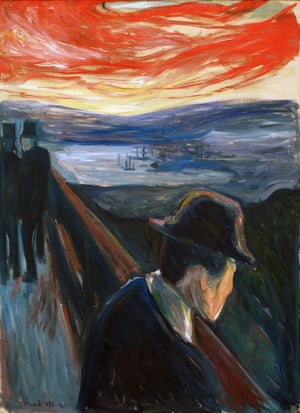
…the image was entitled ‘Sick Mood at Sunset’, a title which places all the emphasis on the subjective quality of the experience. Then, as Munch revolved the figure by forty-five degrees to face us, he changed the title to one in German, Der Schrei der Natur, in keeping with the original inspiration of the image:
I was walking along the road with two friends – the sun was setting – suddenly the sky turned blood red – I paused, feeling exhausted, and leaned on the fence – there was blood and tongues of fire above the blue-black fjord and the city – my friends walked on, and I stood there trembling with anxiety – and I sensed an infinite scream passing through nature (Nice, 22 January 1892)
Given that this diary entry was written in France and yet we know the scene is located in Oslo, he was clearly recalling the experience. Like Bonnard, therefore, he was in the habit of painting and drawing memories, and as with the French artist’s work, this had the effect of altering the colours of recollected scenes; but the one colour that persists through the different versions, when there are colours at all, is this scary red.
The problem with this picture, then, is not that we know too little, but that what we know is full of contradictions. Take the fact that, in the anecdote, nature is shrieking or screaming. This sounds like a simple throwback to what John Ruskin deprecated in the Romantics as ‘pathetic fallacy’, the personification of nature and projection onto it of human feelings. But a confusion arises from the mouth of the main figure. Owing to its shape, just about everybody assumes the figure is doing the screaming. To correct this ambiguity, one can only experiment with the idea of the mouth being closed.
As for landscape, instead of what Ruskin would call pathetic fallacy, it is possible that the concept of the sublime is closer to Munch’s intentions. In philosophy (Kant’s, for example), the sublime leads to sensations of terror and pleasure combined. A severe thunderstorm can have this effect. For Munch, it was an especially gory sunset, but without the pleasure.
Another aspect of ‘The Scream’ is synaesthesia. If we count Munch among the Symbolist artists of his day, then this would have been an experience he prized. The Symbolist poets sought to identify and confound the separate senses of sound and sight, even of smell. In Baudelaire's poem Correspondences, for instance –
There are perfumes that are fresh like children's flesh,
sweet like oboes, green like meadows
– And others, corrupt, rich, and triumphant,
having the expansiveness of infinite things,
like amber, musk, benzoin, and incense,
which sing of the raptures of the soul and senses.
The confusion of sight with hearing accounts for the way Munch’s strangely anonymous figure, suddenly overwhelmed by the lurid redness of the sky, seems to hear it rather than see it. His hands clutch at his ears in an attempt to block the piercing sound. Baudelaire’s word ‘infinite’ also occurs in Munch’s diary entry. The kind of epiphany we are seeing in ‘The Scream’ is cosmic in scale. It is a cry of pain from creation itself. Symbolists didn’t mess about when it came to the sublime. They actively pursued it. But here, the sublime has got too much for one of their number. We are looking at a Symbolist reduced to jelly.
It is no accident that the exhibition includes two portraits of Nietzsche, the German philosopher who Munch appears to have admired most and who wrote at length on the sublime. Though the artist may not have traced the concept back through Schopenhauer and Burke to Immanuel Kant, he has obviously picked up something from the tradition of nature’s potential to terrify. At an earlier stage, when the image still had a German title, the connection between the angst of the figure and the horror of a natural event was more explicit.
The figure is really the most iconic aspect of this persistent image, yet there is something oddly childish about the way Munch chose to depict the face. It is masklike, a caricature without personality. No one ever really looked like this, including the artist. Any remnant of self-portraiture in ‘Sick Mood at Sunset’ has disappeared, to be replaced by a kind of generic arrangement of eyes, nose and mouth. What is this creature? It is like an alien or a robot. It’s a reduced version of a human. The shape of the body is boneless, sinuous, imitative of the landscape or perhaps inseparable from it. From a picture that had to be explained by a diary entry, Munch has created an impression of the feeling of helpless collapse. That body, one feels, will not be able to stand up much longer by its own volition. It has a look of perilous instability. But worse than this imminent collapse is the expression on the face, and especially in the eyes. JoJo once stated that ‘the screamer did not look at the mad sky but directly at us. It is us.’ Well, no. I have already demonstrated that the figure cannot conclusively be said to be screaming, and more to the point, Jones is not looking at the eyes. From the description he gives one would expect a kind of nineteenth-century version of the thousand-yard stare:

But this is not the case. In fact, the creature before us is boss-eyed. He seems to be suffering from strabismus. I don’t think this is an accident, nor is it a medical complaint. Munch is conveying, in a rather cartoonish, almost comical fashion, the idea of panic. So, the right eye of the figure strays too far right for the left eye to keep up. By this trick, the artist manages to introduce animation into the look as the viewer has the same difficulty focusing as the person before them. This was not a trick unique to ‘The Scream’. In 1895, a couple of years after this image of horror, Munch employed the technique again. This time, the figure is that of a jealous man. In the background we see a woman, almost naked, greeting a fully-dressed man in what looks like the act of offering herself to him. The man in the foreground whose face stares out at us, also has strabismus, though this time it suggests that he sees nothing in front of him, his gaze is inward, fixated on the imagined sexual surrender of the beloved woman:
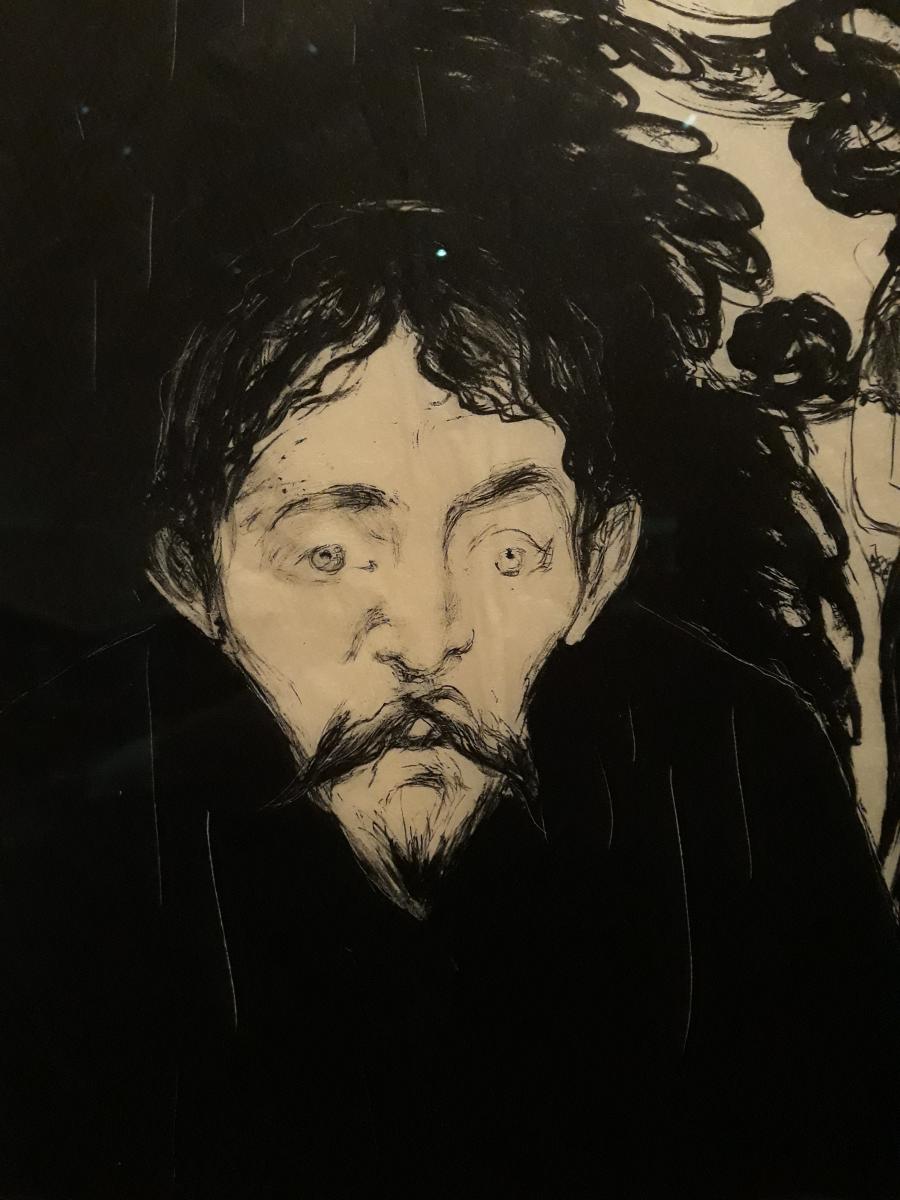
Who can doubt that the expression in Jealousy has essentially the same function as the one in ‘The Scream’, to portray a gaze turned inwards upon the self, oblivious to reality?
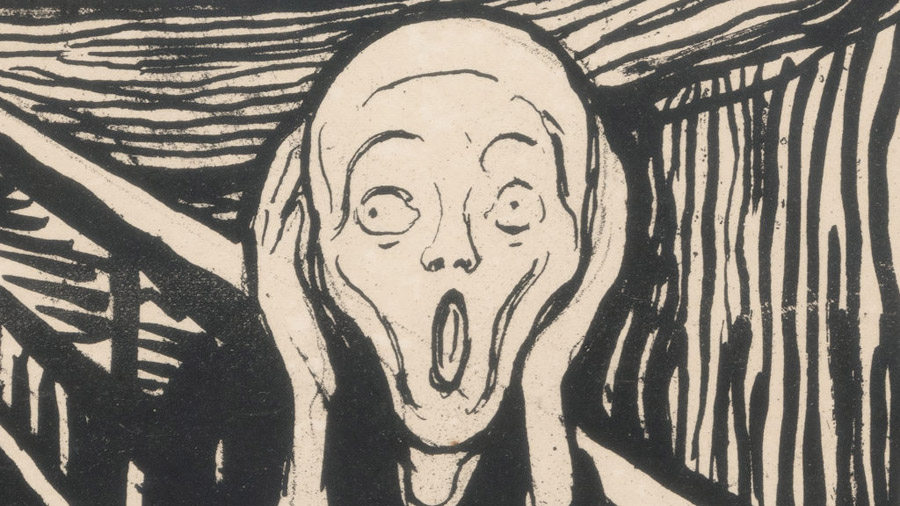
In exactly the same way as the jealous man, the dismayed individual on the bridge is no longer experiencing reality the way normal people do, hence the contrast with the two receding figures. This is definitely an inner state we are being presented with, rather in the way the novel was about to present us with the stream of consciousness.
You may not like getting inside the head of this caricature human being, but that’s where Munch takes us. The fact that he has clearly exaggerated the features to the point of comedy is perhaps the great achievement of the picture. He might easily have avoided this degree of caricature, portraying the man on the bridge in a similar way to the jealous man, yet he opted for something far more grotesque. There is an element of silliness in the result which, though it isn’t unique in his work, contrasts sharply with the grim sombreness of so many of the other pictures in the exhibition; the vampire women, say, or the lovers almost merging into corporate beings with desire. It is only in a picture of a cabaret in Germany that we see what Munch could also have done. He displayed, as Picasso would one day, a real gift for caricature.
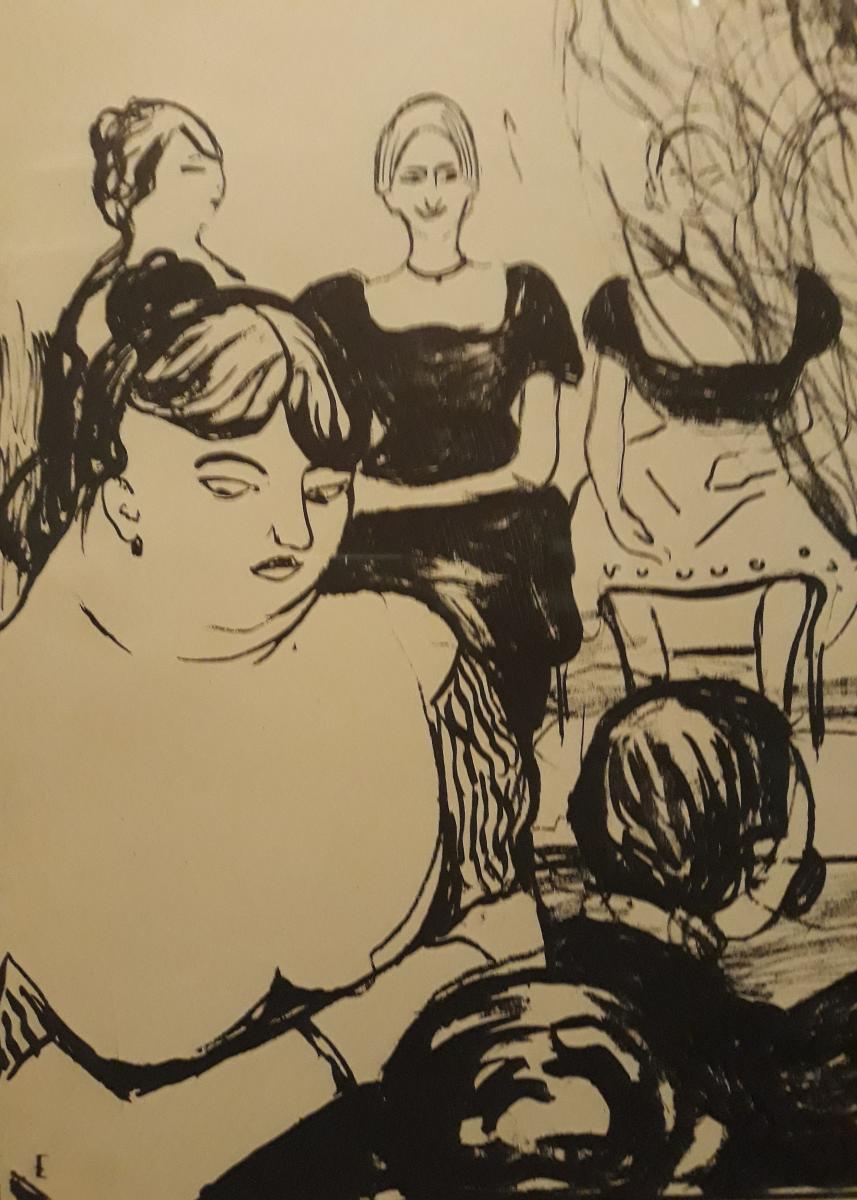
It is this wit in these swiftly drawn portraits that brings me to the comic aspect of ‘The Scream’, because despite all the intellectual baggage, the aesthetic theory, the possible references to breakdown, even the proximity of the scene to a mental home and a slaughterhouse, I really wonder if we have to take it so seriously, or if anyone, even Munch, ever did.
LOOKING AGAIN AT THE SCREAM
‘Andy Warhol looks a scream
Hang him on my wall…’ David Bowie
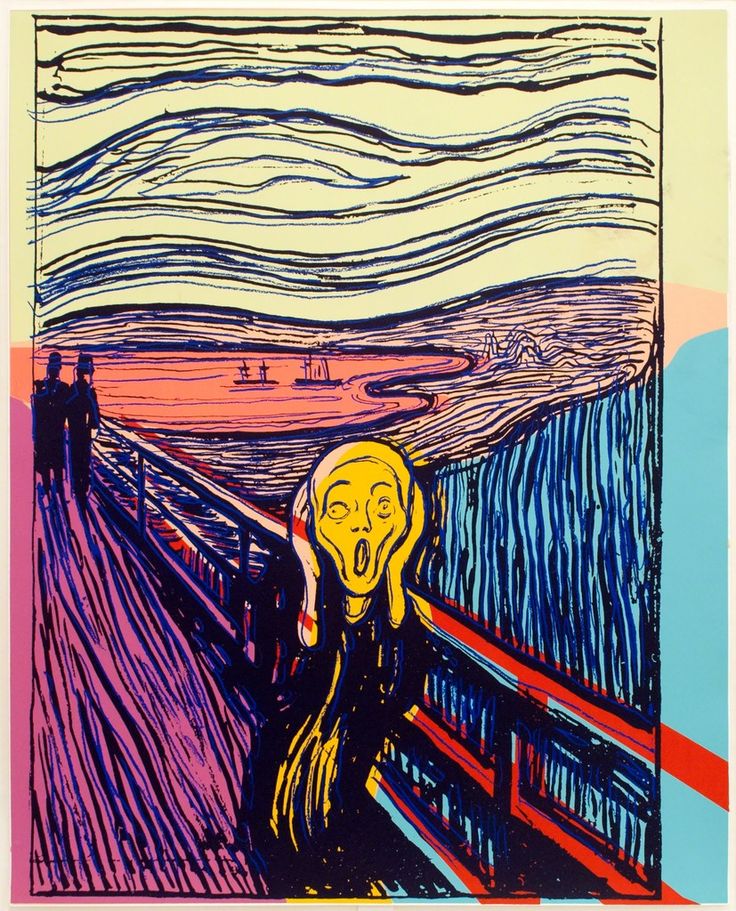
It’s noticeable how little Warhol has felt the need to tinker with the original. He has, however, broken the link made in the diary entry between the blood red of the sunset and the shriek. Does this matter? Here’s another version he did in 1984, which sold for $5.5 million in 2014:
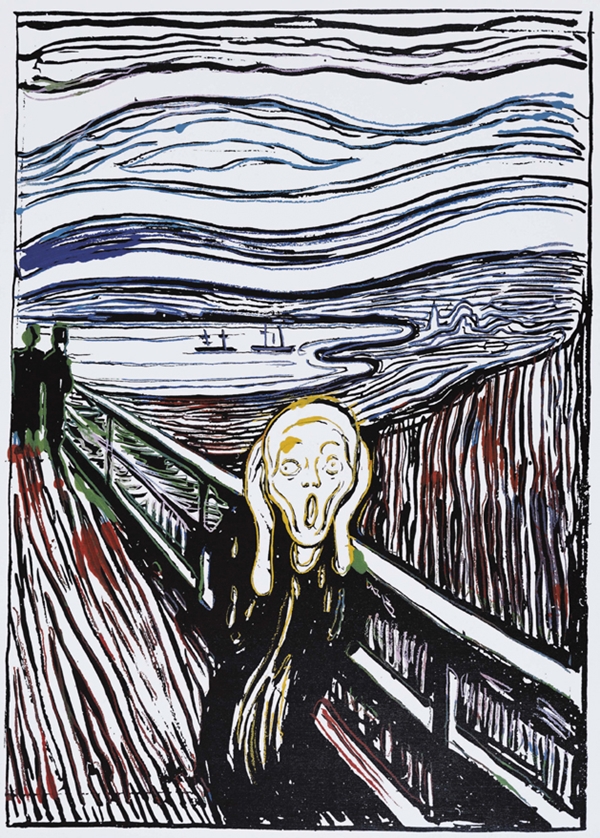
And another, my personal favourite:

This one, consciously or unconsciously, really turns up the volume on the blood red hues, almost as if Warhol knew exactly what he was doing.
There is not a lot more in common between these two artists beyond their means of production, and this is just as well, since we would not otherwise have got the wonderfully meaningless comment by Patricia Berman, writer of the catalogue for Munch/Warhol and the Multiple Image in 2013, that “If Warhol offered himself up as surface, Munch was all impenetrable depth.” After pondering this gnomic remark for some seconds, I was forced to conclude that superficiality and impenetrability amount to the same thing. You learn something new &c.
Warhol made more drastic alterations to Munch’s ‘Madonna’, ‘The Brooch, Eva Mudocci,’ and ‘Self-Portrait.’ With ‘The Scream’, he seems to have restrained himself, content to ring the changes on the colours he used.
Others have not been so discreet. Twenty-five years ago, Robert Fishbone came up with an inflatable version of ‘The Scream’ and has never looked back. To date he has sold 450,000 copies of it in twenty countries. His website promises to ease the tribulations of modern life, ‘whether you are stressed out by politics, the workplace, global warming, a relationship or the rapid pace of technology’.
I’m thinking of emulating Fishbone, but the boneless floppiness of the original would be my chief inspiration, and I would do it not from motives of naked commercial greed, but to do Munch a favour. As I see it, we’ll probably never know if the image is tragic or comic, or even tragicomic, any more than we will ever know what they used to get up to in Stonehenge. The point is to be able to see how extraordinary Stonehenge is, not to pretend you’re a druid. With Munch, we can only hope to see his masterpiece if it becomes strange again. Like the Russian formalists used to say, it has to be estranged. Simply looking at the picture as Munch intended is beyond us. Knausgaard was right, the image is no longer visible. After almost a minute spent scrutinising it, before another punter finally came along to break my reverie, I was really no closer to seeing it. I didn’t even know whether it was clever to have drawn this parody of a human face to communicate whatever he was trying to communicate, or if indeed he was trying to communicate anything.
Which is why I am in favour of the Fishbone inflatables, and of mugs, and T-shirts, and all the gift shop trash which has made such a comprehensive mockery of the original intention behind the image. Since that intention is now irredeemably lost, never to be recovered, I have decided to design my own Scream as a dancing, flailing tube man of the kind that smiles inanely in shopping malls, gas stations and car showrooms across the length and breadth of America.
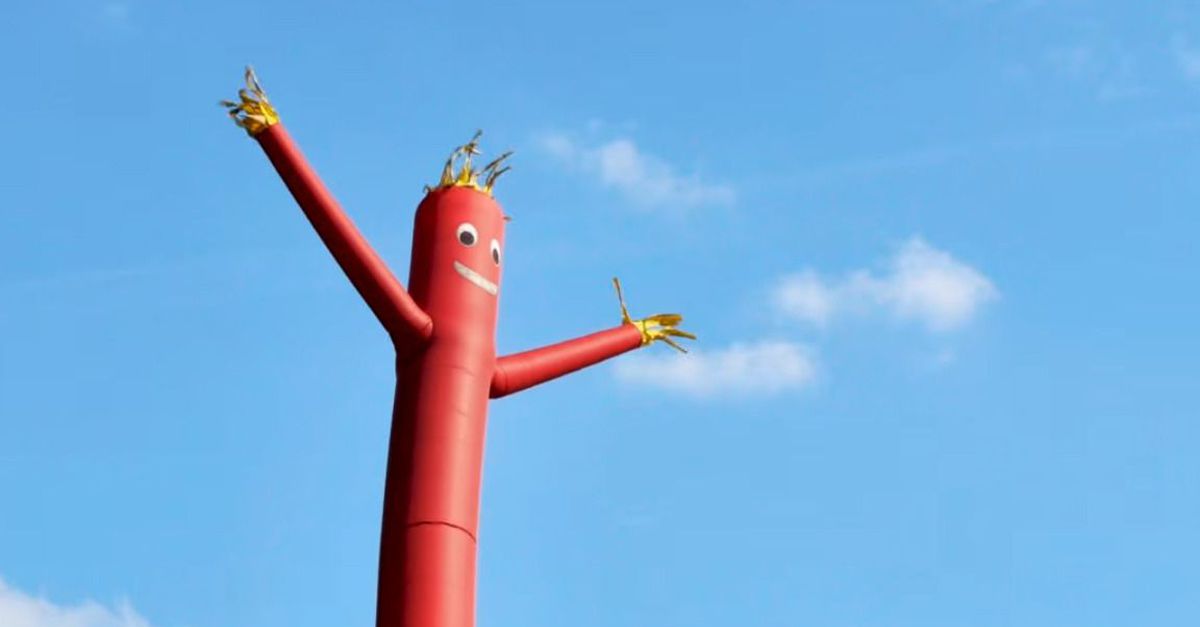
It’s what Munch would have wanted. They flop down periodically and then rise again, flailing their arms about. Mine will not flail its arms about, obviously. It will have its hands over its ears. Otherwise, it will pretty much mimic the spasmodic movements of its more cheerful forbears. Apparently, these crazy ‘tube guys’ are not just aesthetically pleasing and hilarious, but
…vertical inflatables also make for good scarecrows. Farmer Gary Long […] says that bird damage in his orchard of honey crisp apples went from 20,000 pounds a year to zero (Slate, 3 December 2014)
Imagine how much more efficient one of Munch’s tube guys would be. The crows would not just get scared; they’d actually begin to experience angst. I should be able to flog these tubes to art lovers and irate farmers alike, and you know what, I shall be doing Munch a favour, because I’ll be making his overfamiliar icon visible again.
‘Edvard Munch: love and angst’ is at the British Museum until 21 July 2019.







